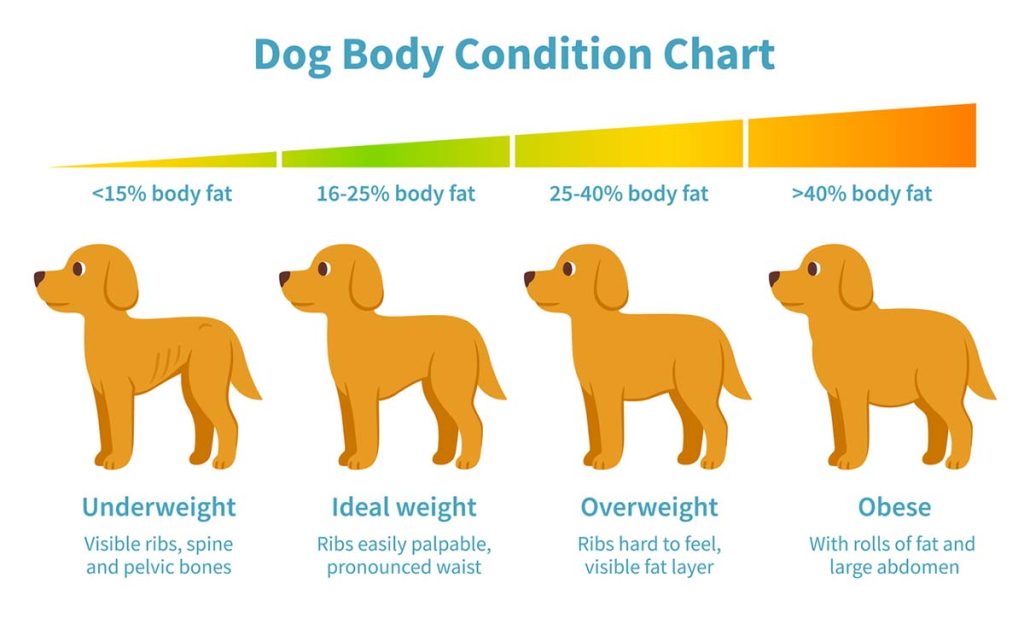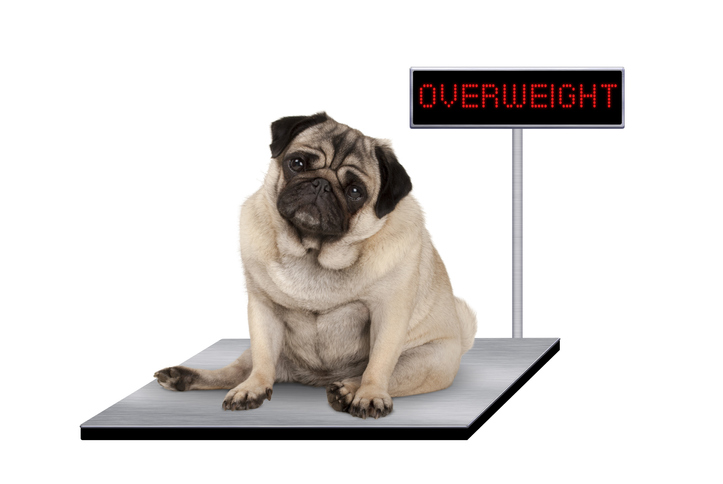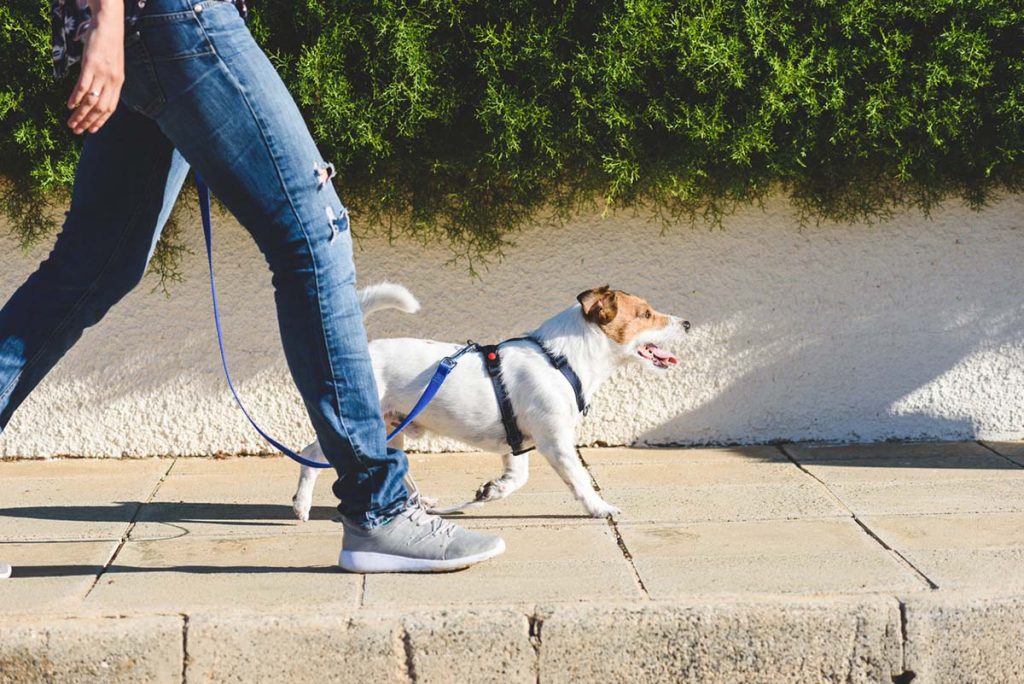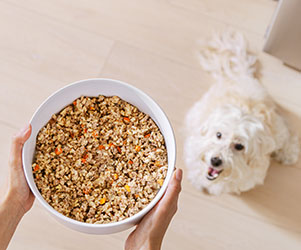5 Ways to Help Your Dog Lose Weight
Obesity is an epidemic. Helping your dog reach or maintain an ideal weight is key to their health, happiness, and longevity.
Do you have a chunky Chihuahua? A rotund Rottweiler? A plump Pekinese? If you’re a pet parent in America today, there’s a pretty good chance the answer is yes. In the United States alone, an estimated 50 million dogs are overweight or obese, according to the Association for Pet Obesity Prevention (APOP).
And even if you think your perfectly-fit pooch is in the clear, you may want to think again. In an earlier study, APOP found that 95% of dog owners of overweight dogs incorrectly identified their pet as having a normal weight.
No matter where your dog falls on the weight spectrum — whether they need to drop a few pounds or simply maintain their current weight — one thing is clear: Helping your dog reach or maintain an ideal weight is key to their health, happiness, and longevity.
“Dogs that are overweight can be predisposed to many different health problems,” explains Dr. Jessica Wilson, DVM. “Carrying extra weight is going to severely impact your dog’s mobility. And that can lead to pain and discomfort and more wear and tear on the joints over time. Most health issues can be better managed by keeping your dogs at a more ideal body weight.”
Obesity is not helping anyone’s quality of life. In fact, it shortens your dog’s life. Pet owners of overweight dogs need to create and stick to a weight management plan.
Here’s the good news: There are plenty of ways you can help your dog achieve a healthy weight. Thanks to scientific advances in veterinary science and nutrition, doing so is easier than ever.
How to Know If Your Dog Needs to Lose Weight

When it comes to weight loss, the first step is figuring out where you are and how far you have to go. For us humans, that’s pretty easy to determine (though decidedly harder to accept and even more difficult to achieve).
But for dogs, it’s complicated, according to Dr. Wilson.
“Honing in on an exact weight is challenging because we have to look at a variety of factors — males are built differently than females; younger dogs have a little bit more muscle mass than older dogs; spayed and neutered dogs weigh more than intact dogs,” she says. “So the number is a little tricky.”
The number on the scale can provide some clues — especially if it’s been ticking up. But your veterinarian is more likely to rely on your dog’s body condition score to determine if it is overweight or obese. These qualitative scores take into account how much fat your dog is carrying on his frame.
At an ideal body condition, your dog will have an “hourglass” figure with a visible tuck at their waist (behind the last rib) and an abdominal tuck on their underside (where the stomach arches toward the hips), with no noticeable fat covering his ribs. Overweight and obese dogs have sagging stomachs, thick waists, and a layer of fat covering their ribs.
If you prefer to rely on cold, hard numbers, look for a weight chart specific to your dog’s breed. Compare your dog’s weight to the ideal weight range for the breed. These charts can be a good guideline. But Dr. Wilson suggests having your dog evaluated by a veterinarian to determine your dog’s health goals such as ideal weight.
“Yes, there are guidelines for certain breeds, however, we still need to treat them all as individuals,” Dr. Wilson adds.
How to Help Your Dog Lose Weight

No one likes to hear that they need to drop excess weight, humans and dogs alike. But your dog has an advantage many humans don’t: a built-in weight-loss coach…you!
That’s great news for dogs. (Who wouldn’t want live-in meal prep, training support, and accountability?) But it may feel a little overwhelming to pet parents dealing with a hangry hound who’s completely over their low-calorie doggie diet.
“The hardest part in managing weight loss for pets, for dogs specifically, is that they are typically very food motivated,” says Wilson.
Here are some tried-and-true tips and expert insights to help you get the numbers on the scale moving in the right direction:
1. Count calories
Watch your dog’s caloric intake. Reducing the number of calories in your dog’s diet is one of the most effective ways to help your pet lose weight. But there’s more to this numbers game than meets the eye.
According to Dr. Wilson, if you use the weight-based feeding guidelines printed on the kibble bag to portion out the pet food, you could still be overfeeding your dog.
“You need to calculate how many calories your dog needs to consume based on their ideal body weight, not their current weight,” Dr. Wilson says. “If you feed them for that current weight, they’re just going to stay at that weight.”
Calculating your dog’s caloric and nutritional needs is based on highly individualized factors. Factors include overall health, metabolism, and whether your dog is spayed or neutered. So it’s important to work with your veterinarian to establish the ideal number of calories your dog needs to achieve their goal weight.
Even then, keep in mind that not all calories — or dog foods — are created equal. Be sure to make every calorie count. Choose dog treats and a dog food that’s packed with everything your pet needs to thrive, despite the calorie restrictions.
You can use the JustFoodForDogs feeding calculator to determine the ideal combination of calories and nutrients your dog needs, based on their unique profile, health history, and activity levels.
2. Practice portion control
Carefully measuring your dog’s food is an important part of your dog’s weight loss journey. But you’ll have a greater chance of weight loss success if you think outside the measuring cup.
First off, consider trading your measuring scoop for a scale. According to research published in Veterinary Record, even pet parents who measure out dog food often over-measure portions. In some cases, they feed their dogs up to 152% more than the recommended serving size.
“If you’re a pet parent who isn’t measuring out the appropriate quantities of the kibble, you may be feeding extra and that’s an easy way to encourage weight gain,” says Dr. Wilson.
A scale will give you a more reliable and consistent serving size. Or, you can use it to confirm the correct amount of food in a serving; then use a scoop that fits just that amount.
If you find that your dog is wolfing down their food too quickly and looking for more, try adding the portion to a puzzle feeder. That can help stretch out the meal. Plus, it creates opportunities for physical and mental stimulation to take your pet’s mind off their hunger.
3. Focus on what’s in their food

You don’t have to be a life-long dieter to know that 500 calories worth of green beans and 500 calories worth of potato chips affect your body in very different ways. When you’re helping your dog shed some weight, what your dog eats matters as much as how much of it.
“Kibble diets tend to be a bit more calorically dense,” says Dr. Wilson. “If you’re trying to do a weight loss plan by only feeding kibble, you may have to restrict the volume of kibble and then your dog is just hungry all the time.”
Switching to fresh whole food options with human-grade veggies and protein, such as JustFoodForDogs Fish & Sweet Potato recipe. This allows you to feed your dog a larger volume of food that is lower in calories and fat. This helps them feel satiated. The extra moisture in fresh whole foods also helps your dog feel full, making it easier to lose weight. Fresh food diets are clinically proven to improve overall immune health and wellness.
4. Scale back on treats
What pet parent doesn’t love to see their good boy or girl perk up at the first sign of a treat or table scrap? However, the extra calories in those well-intentioned rewards could be doing your pet more harm than good.
As a general rule, treats should make up no more than 10% of your dog’s daily calorie intake. According to Dr. Wilson, a single tablespoon of peanut butter contains a whopping 94 calories. If you’re not paying close attention, those calories can add up fast and undermine your weight loss plan.
“The easiest thing to do is eliminate the treats and then reassess after a few weeks to see if their weight has budged,” Dr. Wilson advises.
In the meantime, you can look for ways to replace food rewards with something else your dog really enjoys. For example, extra pets or attention from you, a game of fetch, or a new toy.
If and when you do decide to add treats back on the menu, look for healthy, nutritious options like single-ingredient lean, high-protein Chicken Breast Treats, or low-fat Salmon Bark for Dogs. And count those calories as part of your dog’s daily target.
5. Get moving

Feeding the right diet with fewer calories is the primary way to help your dog lose weight, but exercise matters, too.
“If a dog is not getting enough activity and is consuming a larger number of calories, then that’s going to make it easier for them to gain weight or harder to lose weight,” says Dr. Wilson.
As you adjust your dog’s diet, be sure to make up for any food restrictions by adding more walks, trips to the dog park, games of fetch, and other physical activities into your dog’s daily routine to help your overweight dog drop pounds.
If your dog is slowing down due to age or mobility issues, even tiny changes can help. Consider moving their feeding station during mealtimes to another part of the house. This will motivate them to move more. Or gradually increase the length or duration of walks over time.
How to Prevent Obesity in Dogs
Preventing dogs from becoming overweight or obese in the first place is the best way to guard against weight-related medical conditions ranging from osteoarthritis and type 2 diabetes, to heart disease and shortened lifespans.
Wilson suggests encouraging good habits early on. Feeding a healthy diet in the correct proportions, limiting treats, and prioritizing an exercise plan will ensure that your pet maintains a healthy weight throughout their life.
“Prevention is key, especially for certain breeds that have the propensity to have health issues related to obesity,” she says. “If you can prevent your dog from becoming obese, then hopefully we can keep that pet active and pain-free throughout their lives.”
Jodi Helmer writes about companion animals and livestock for NPR, Out Here, National Forests, WebMD, Hobby Farms, and Backyard Poultry. She shares her North Carolina home with a pack of elderly rescue dogs that like to bark at the donkey, goats, and chickens.
This content is for informational use only and does not replace professional nutrition and/or medical advice, diagnosis, or treatment. It is not a substitute for and should not be relied upon for specific nutrition and/or medical recommendations. Please talk with your veterinarian about any questions or concerns.







